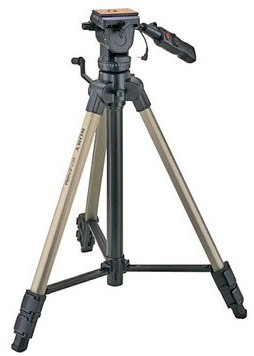Tripods can all seem the same but there’s more to them than meets the eye. When people ask “What tripod should I buy?” I normally offer them these tips:
Tip #1 — Choose the Head Carefully
Consider what type of head you need. The head is the mechanism that allows you to point your camera in different directions. A standard head like the one in the photo below has a handle and/or knobs that let you move your camera up and down (tilt) and side to side (pan). These ‘pan and tilt heads‘ are fine for video where a smooth ‘panning’ action is often required. But it can be annoying to use a pan and tilt head with a stills camera. Many ‘pan and tilt heads’ require you to use two separate controls to move in the two directions. That’s annoying. Instead, consider a high quality ‘ball and socket head’. These cost more and support less weight for the money than a pan and tilt head but I find them far easier to use. Again, what you pay will determine the quality you get – my ball and socket head wasn’t cheap!
Never seen a Ball and Socket Head? Take a look at this YouTube video.
Tip #2 — Don’t Go Cheap
This is going to sound obvious but one of the primary purposes of a tripod is to stabilize your camera and reduce camera shake. Sometimes all you need is a low cost lightweight tripod but only go lightweight when all you need is a modest amount of stabilization. When you need it to hold up against a little wind (see Tip #4) or go tall then a lightweight isn’t going to do as good a job as its heavyweight cousin. Pay as much as you can justify for the most sturdy tripod you can.

Tip #3 — Try Before You Buy
Go to a store and use it before you buy. It’s tempting to buy a tripod on-line but if you’re disappointed with it when it arrives it can be a lot of trouble to return it. I’d definitely recommend going to a good camera store and use a number of tripods before you buy. It’s the little things such as the way the legs are adjusted that, if not designed well, can slow you down and become annoying.
Tip #4 — Do You Need a Hook?
If you do buy a lightweight tripod, check for a hook at the bottom of the central column. Although I don’t recommend using lightweight tripods at times when a heavier one is needed sometimes you have no choice. On those occasions adding a little low hanging weight to the tripod can provide the stability you need. An easy way to do this is to fill a bag with some rocks and hang the bag from the center column of the tripod. A hook on the central column can make this job easier. Be careful though – too many rocks that that tripod will break!
Tip #5 — Treat it Well
Treat your tripod well. A good quality tripod should last you a lifetime. If you get it wet or salty, wash off the salt and let it dry. If you get sand or grit in the mechanisms, take care of that. Follow whatever care regime the user manual recommends and a good quality tripod will almost certainly outlast any camera you ever buy.
Please Share!
If you found this article useful, please share it. Shares help us realize that people like our work and motivate us to write even more great articles like this one!
Your Opinion Matters
We'd love to read what you think about this article. Do you have a comment? Is there something that needs to be added or a fact that's wrong? Please use our Comment box to tell us about it.
Keep Up-to-Date
To have early bird access to our new courses, books and tutorials subscribe to our free newsletter. Don't miss out on our next post — Like our Facebook Page, follow us on Twitter or add us to your circle on Google+. You can also subscribe to our YouTube Channel.

hey thanks for the tips but you didnt show any pictures of the ball and socket head. what is it? ive never seen one. where can you buy them.
Hey Grahame, thanks for the question. I hadn’t considered this but, you’re right, few people ever see a Ball and Socket head. That’s a shame as, personally, I think they are far better for photographers (it’s different for videographers) than the cheaper pan/tilt head that tend to be sold with tripods .
I’ve made a YouTube video that shows a high-end Ball and Socket head. I’ve edited this article and embedded the video in to it, so please just come back and re-read the article.